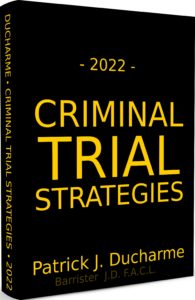The law of procedure is closely linked to the law of evidence. Subsection 723(5) of the Code, for example, provides that hearsay evidence is admissible at sentencing proceedings. In order to know the differences in the procedure from trial to sentencing, it is necessary to know the rules of evidence in order to correctly apply the rules of procedure. At trial, hearsay evidence is generally not admissible and at sentencing hearsay evidence is admissible. There are three main sources of the rules of evidence. The primary source is the common law. Judges “make” or pronounce much of the law of evidence. Statutes create some of the rules of evidence. For example, some of the rules concerning the competence of certain persons to be witnesses and the admissibility of some classes of evidence such as business records can be found in the Canada Evidence Act. Lastly, evidentiary rules are impacted by Charter decisions. The laws of evidence relate to the information a court will receive and consider in making its decisions.
There is a basic principle arising out of the Rule of Law that newly enacted laws not be applied retrospectively. At the same time, however, courts have accepted that amendments of a procedural/evidentiary nature may properly be applied retrospectively. Indeed, the rules of statutory interpretation have developed a presumption that amendments to procedural law are to be applied retrospectively, while amendments to substantive law are not. However, as Ruth Sullivan has observed, the determination of whether an enactment is “procedural” or “substantive” is not simply a matter of attaching a label, but requires an assessment of the impact of the amending provisions in the circumstances of the case.
Recently, the Supreme Court of Canada made clear that the presumption in favour of the retrospective operation of a procedural enactment only operates when the enactment is exclusively procedural. According to Arbour and Iacobucci JJ. writing for the majority, in Application under s.83.28 of the Criminal Code (Re)2 an evidentiary enactment that impinges upon substantive or vested rights is not exclusively procedural and, thus, will not be given retrospective effect.
Driedger and Sullivan3 generally describe procedural law as “law that governs the methods by which facts are proven and legal consequences are established in any type of proceeding.” Within this rubric, rules of evidence are usually considered to be procedural, and thus to presumptively apply immediately to pending actions upon coming into force.4 However, where a rule of evidence either creates or impinges upon substantive or vested rights, its effects are not exclusively procedural and it will not have immediate effect.5 Examples of such rules include solicitor-client privilege and legal presumptions.
Similarly, where a putatively procedural provision impacts on the existence or content of a defence, the courts have considered the enactment to be substantive and, therefore, have not applied it retrospectively. For example, in Angus v. Sun Alliance Co., provisions of the Family Law Reform Act, 1975, that removed a bar to a spouse recovering damages against his or her spouse, did not apply retrospectively in respect of a claim that arose before the legislation came into force.
La Forest J. wrote:
Even if one assumes the provision in question is procedural in some sense, the judicially created presumptions regarding the retrospective effect of procedural rules were not devised with this sort of distinction in mind. Normally, rules of procedure do not affect the content or existence of an action or defence (or right, obligation, or whatever else is the subject of the legislation), but only the manner of its enforcement or use. Alteration of a ‘mode’ of procedure in the conduct of a defence is a very different thing from the removal of the defence entirely. The latter is in essence an interference with a vested right.
The criminal law is not, however, all about the proof of intention coupled with an act amounting to criminality. It also incorporates, however, the concept of negligence. Take for example the charges of dangerous driving or driving with criminal negligence. There are also charges related to creating harm or death by criminal negligence. It is in this difficult area of criminal law that the courts have struggled with the precise wording of our legislation. In one of those areas the courts had to define what is meant by the word, “purpose”. It also provided the court with an opportunity to address problems in the area of the doctrine of wilful blindness.
The Supreme Court of Canada in Briscoe7 decided to clarify the meaning of the word purpose in subsection 21(1)(b) of the Code. In this case the court decided that the word purpose has two components, namely, intention and knowledge. In order to satisfy the intentional component the prosecution must prove that the accused intended to assist the principal in the commission of the offence. It is significant to note that the court suggested that it is not required that the accused desire that the offence be successfully committed.
To meet the knowledge requirement, the prosecutor must establish that the accused aider knew that the principal intended to commit the crime, regardless of whether or not she knew precisely how the crime would be committed. The court found it was therefore sufficient that the accused aider have knowledge of the principal’s intention to commit the crime, and then act with the intention of assisting the principal in its commission.
With regard to the doctrine of wilful blindness, the court established that it should be considered distinct from recklessness. The doctrine requires that the court delve into the accused’s state of mind in an effort to establish knowledge. Wilful blindness, the court said, could substitute for actual knowledge whenever knowledge is a component required to prove the crime. The court concluded that wilful blindness imputes knowledge to an accused whose suspicion is aroused to a point where he needs to make further inquiries, but instead, deliberately chooses not to make those inquiries. In the Briscoe case, for example, the aider provided statements to the police that demonstrated he deliberately chose not to inquire about plans of others to kidnap and sexually assault, despite the fact that his suspicions were aroused, “because he did not want to know”.
The above is the an excerpt of Patrick J Ducharme’s book, Criminal Trial Strategies, available at Amazon or in bulk through MedicaLegal Publishing.
Read or listen to the Preface and Introduction and subscribe to Patrick Ducharme’s Youtube Channel.

